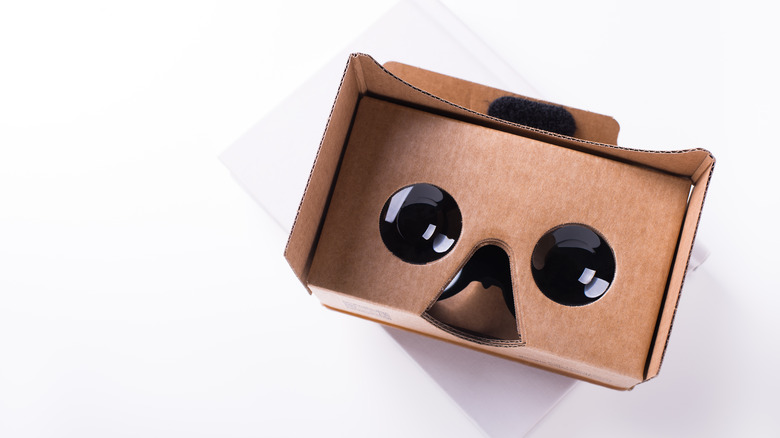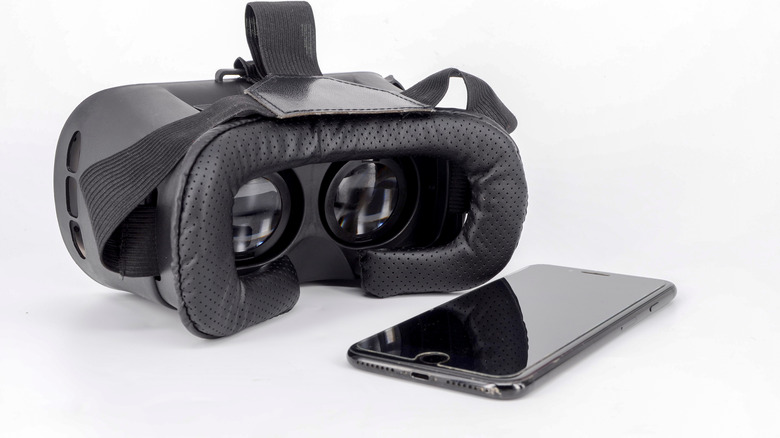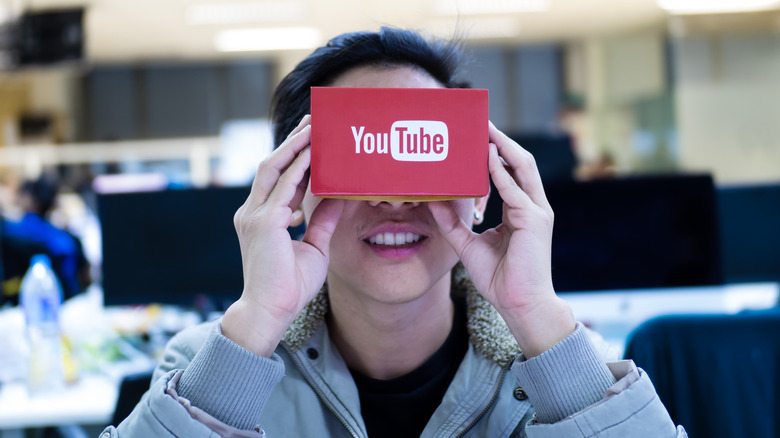How To Use An Old iPhone As A VR Headset
VR isn't as expensive as it used to be. A few years ago, you needed a high-end gaming PC and a headset that could cost close to a thousand dollars. Now you can experience VR for as little as $300 with an all-in-one headset like the Meta Quest 2. If $300 is still out of your budget and you have an old iPhone in a drawer, you can actually step into VR for even less than that. Phone-based VR systems aren't as high-quality as dedicated headsets. The games will be limited, as will the motion tracking and visuals. But everything will still be in 3D and you'll get a taste of what a modern VR experience can be.
All of the systems we're going to discuss below are basically boxes with lenses you can clip your phone into. These systems are then combined with VR apps — most of which are based around Google Cardboard. The apps will display two images — one for each lens — which give the illusion of 3D. Your phone's accelerometer will be used for tracking, allowing you to look and sometimes move around the virtual space. A set of headphones can also improve immersion if an app has 3D audio. The Cardboard app itself requires iOS 13, so that old iPhone should be an iPhone 6S at a minimum. Requirements for other apps will vary.
The cheapest option: Google Cardboard
When it first launched in 2016, Google was selling cardboard viewers, which were genuinely just cardboard cuboids with lenses inside, for as little as $5. Google discontinued its cardboard headsets in 2021 (via 9 to 5 Google), but links to third-party alternatives are still listed on its site and are still the cheapest option. Like the original, most of the options listed on the Google site are made of cardboard. The cheapest options still retail under $10, with the Vusion V3 being the cheapest option, priced at just $8.95. The pricier options on Google's site contain plastic and may last significantly longer than the fragile cardboard options.
The cheaper versions of Google Cardboard also lack head straps and have to be held to the user's face. That should be fine as they also lack controllers so Google Cardboard users won't be doing anything important with their hands anyway. Google Cardboard-style headsets tend to arrive flat and have to be folded into shape. Users then load a VR app on their device and then place their phone inside the headset, lining it up with the lenses. In addition to the lack of a controller, most of the cheaper cardboard headsets offer no way to interact with a phone while it's in the device, so the headset has to be opened again if an app asks you to select an option. Despite the shortcomings, a basic third-party cardboard headset, an old iPhone, and some free apps could see you experiencing VR for under $10.
A more expensive, but far better option
There are more advanced, more expensive options that still use the same basic idea as Google Cardboard. You will still be loading an app and then placing your phone in some kind of headset. But your extra money will get you a durable plastic headset, an easier and more secure way to insert your phone, a head strap, ways to interact with a phone while it's in the device, and extra features like built-in headphones.
At the high-end of the spectrum is the Merge AR Headset. Priced at $49.99, the Merge's primary focus is educating children and the headset's creators have also compiled the Merge Miniverse, which is a list of informative and fun iOS-compatible apps. As a headset, the Merge is light and durable, includes buttons that interact with your phone while it is inside the headset, and allows you to adjust the distance between the headset's lenses.
The Destek V5 headset is a cheaper — and arguably better — option, usually retailing at $34.99. For your money, you get a 110-degree field of view, a trigger button on top of the headset, and support for users who wear glasses. Destek's effort also includes blue light filtering lenses and a Bluetooth controller, although the controller has limited functionality on the iPhone.
A cheaper, yet still good, option is the Pecosso 3D headset, which is priced at $20, has a 90-100 degree field of view, and is designed for comfort. Like the other options in this category, the Pecosso offers ways to adjust both the focus and distance between the lenses — which should reduce motion sickness.
The best apps currently available
The Google Cardboard app is a great entry point into VR. It has a small number of experiences that don't put too much strain on the user while showing off what even a basic VR setup can do. YouTube for iOS is another great starting point and is an app you may already have. Some videos, including a number of 360-degree experiences, have an option to view in VR by clicking the Google Cardboard icon at the bottom of the video's box. Google Street View has a similar option and will allow you to "travel the world" virtually. All of these options only require the user to look around and drink in the atmosphere — so the lack of any kind of controller won't take away from the experience. If Youtube doesn't offer enough experiences for you, consider with.in. The app comes with an extensive range of VR experiences that work with the iPhone; several of the experiences are interactive and most of them are completely free.
For users with a stronger stomach, "Roller Coaster VR Theme Park" puts you on a variety of virtual roller coasters. While there are no G-forces, the visuals may be enough to make your stomach drop a few times. iPhone users don't miss out on social interactions either. Highly-rated social app "Rec Room" works with devices running iOS 10.5 or later. As well as social interactions, Rec Room contains several game modes including a very entertaining paintball game — though this will require a controller setup.



